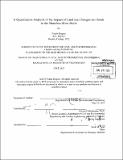A quantitative analysis of the impact of land use changes on floods in the Manafwa River Basin
Author(s)
Bingwa, Fidele
DownloadFull printable version (8.679Mb)
Other Contributors
Massachusetts Institute of Technology. Department of Civil and Environmental Engineering.
Advisor
Richard Schuhmann.
Terms of use
Metadata
Show full item recordAbstract
Flood events in the Manafwa watershed, located in eastern Uganda, have increased in frequency in recent years. The risk of flooding is increasing globally due partly to climate change which enhances the number of weather extremes like excessive rainfalls or droughts. This increase in flood events is also a response to land use changes; as more people use the land for agriculture and housing the percentage of less pervious and impervious area increases. Floods in the Manafwa watershed are often deadly and always an economic burden. In eastern Uganda there is little that can be done about climate change but land use changes can be managed. This study analyzed the impact of land use changes on floods in the Manafwa watershed in hopes of informing local leaders regarding future flood risk reduction. The analysis was conducted using a hydrologic model of the Manafwa watershed. The model had two main components: a meteorological model and a basin model. The meteorological model contained past rainfall data of the watershed and the basin model used the SCS curve number method as its soil water loss method. The curve number determines the percentage of rainfall water that becomes runoff, and is derived empirically from land use or land cover information as well as the soil type. A curve number map of the watershed was created using current land use and soil data; land use changes were modeled by making modifications to the land use map which resulted in changes on the curve number map. In addition to modeling the current land use condition, three land use changes were simulated and the outflow result showed that land use changes can affect river flow and hence flood events in the Manafwa river basin. The results also show that a land management program like reforestation could decrease the risk of flooding in the watershed.
Description
Thesis (M. Eng.)--Massachusetts Institute of Technology, Dept. of Civil and Environmental Engineering, 2013. Cataloged from PDF version of thesis. Includes bibliographical references (p. 41).
Date issued
2013Department
Massachusetts Institute of Technology. Department of Civil and Environmental EngineeringPublisher
Massachusetts Institute of Technology
Keywords
Civil and Environmental Engineering.